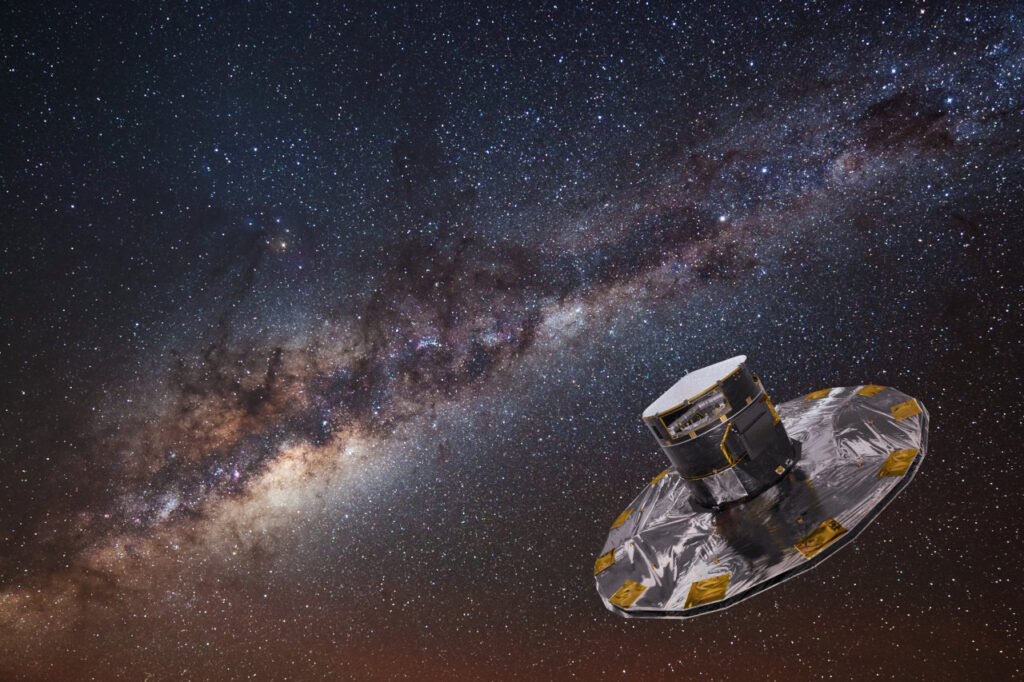[LUM#5] Discovering the Universe
December 2013: the sun discovers a new satellite. The latest addition is Gaia. Its mission: to explore a galaxy as close to our own as it is little-known. And to help us better understand the universe...

50 billion pieces of data: that's what the European Gaia satellite sends us every day, exploring the farthest reaches of our galaxy. It took no less than 3 years to begin deciphering this enormous mass of information, thanks to complex software, some of which was designed by the Montpellier Universe and Particles Laboratory (LUPM). Your computer, on the other hand, would have taken hundreds of years to do the job...
Mapping the galaxy
Comfortably wedged around the " Lagrange point " 1.5 million kilometers from us - the precise point in the Sun-Earth system where the forces of attraction between the two bodies balance out - Gaia observes, catalogues and calculates. And we're making giant leaps forward in our knowledge of the Milky Way. Because most of the objects observed by the satellite were poorly known until now: " Gaia has collected data on 1.15 billion stars. That's gigantic! Until now, we only knew the distances to around 100,000 stars," enthuses Gérard Jasniewicz, astronomer at LUPM.
The primary objective of the Gaia mission is to measure the positions, distances and movements of celestial objects within the galaxy. The stakes are high: " the aim is to establish a three-dimensional map, the most accurate ever obtained. This will enable us to understand the very structure of our galaxy ", explains Fabrice Martins, also an astronomer at LUPM.
A galaxy that remains largely unknown. But why? First of all, because it's gigantic. Any idea of its size? If we could travel at the speed of light, it would take us around 100,000 years to cross it from one side to the other... " With Gaia, we'll be able to precisely map all the bright stars in our galaxy. With Gaia, we'll be able to precisely map all the bright stars in our galaxy located less than 30,000 light-years away ," explains Gérard Jasniewicz.
Time machine
If the Milky Way is poorly understood, it's also because we're part of it. It's paradoxical: in some respects, we know less about the Milky Way than we do about other galaxies," says Fabrice Martins. We don't have the distance we need to get an overall picture. Many stars are hidden from us by clouds of gas and dust that form an impenetrable curtain for telescopes.
Star brightness, position and speed: the European satellite and its many instruments (see box) have a lot to teach us about these fundamental data. LUPM has been assigned the crucial task of working on the "radial velocities" of stars - the speed at which they approach or recede. " Gaia will also reveal the intrinsic brightness of stars, and therefore their mass: this is crucial data for characterizing them," continues Fabrice Martins.
A way to better understand the brilliant populations - blue, white, yellow, orange, red, dwarf, giant, supergiant stars... - that populate our galaxy. Many LUPM researchers working on star classification are eagerly awaiting these results, which will enable them to verify hypotheses, models and theories. And they're not alone. Gaia is the dream of the global scientific community, which will have free access to all the project's data. And they hope to soon see new horizons open up in a wide range of disciplines...
New horizons
As explorer and cartographer of our galaxy, Gaia is also its archaeologist. Speeds, displacements, the age of stars and their chemical composition all provide valuable clues to the galaxy's past and the way it was formed. " A telescope is a time machine! " sums up Gérard Jasniewicz.
At the end of its mission, which is due to last until 2020 but could well be extended, the Gaia satellite will have advanced our knowledge in every direction, opening our eyes to a wide range of subjects: quasars, exoplanets, asteroids, other galaxies... This galactic encyclopedia will even enable us to verify the effects of universal gravitation on very large scales. And thus test the fundamental laws of physics. It's an encyclopedia so vast that scientists are looking forward to the sheer number of study subjects it offers... and all that remains to be explored.
"Revolutionary
The Gaia project means " more objects mapped, more precisely and further afield ", as scientists put it. A "revolutionary" satellite that observes 50 million stars every day.
Equipped with two telescopes, this concentrate of technology is also fitted with 106 sensors: the equivalent of a camera with a resolution of one billion pixels. 450 scientists from 25 European countries are working on this project, led by the European Space Agency (ESA ).
UM podcasts are now available on your favorite platforms (Spotify, Deezer, Apple podcasts, Amazon Music...).